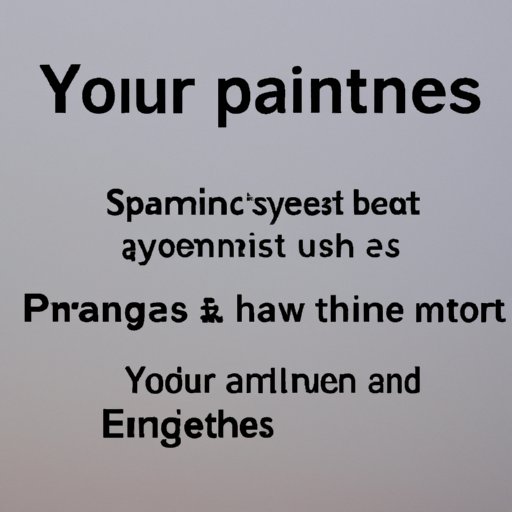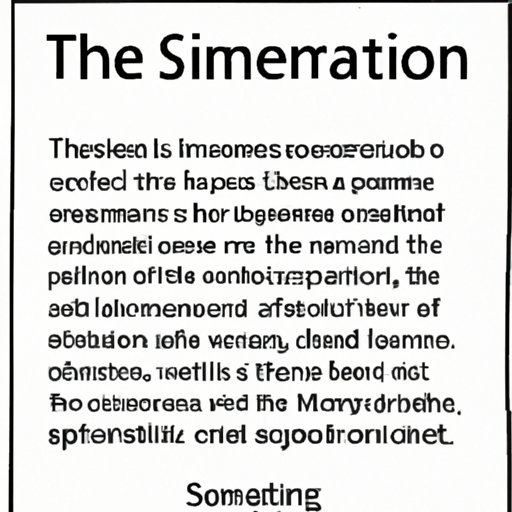Introduction
A conclusion paragraph is the last part of an essay, report, or speech. Its purpose is to summarize the main points, restate the thesis statement, offer a final thought or call to action, and provide a sense of closure. In this article, we will explore how to start a conclusion paragraph with examples of each of these elements.

Summarize the Main Points of Your Argument
It is important to summarize the main points of your argument in the conclusion paragraph. This helps to tie all of the ideas together and reinforce the main points that you have been discussing. To do this effectively, you should focus on the most significant points and use concise language to get your point across.
For example, if you were writing about the importance of education, you might say something like, “In conclusion, education is essential for success in life. It provides opportunities for better jobs, higher wages, and greater personal satisfaction. Education also has the power to open doors to new worlds and experiences.”
Restate Your Thesis Statement
Another important element of the conclusion paragraph is to restate your thesis statement. This is a way to bring the essay full circle by emphasizing the main point that you set out to prove in the introduction. Restating the thesis statement should be done in different words than what was used in the introduction, but it should still convey the same message.
For example, if your thesis statement was, “Education is essential for success in life,” you could restate it in the conclusion as, “It is clear that education is a critical component of achieving success in life.”
Offer a Final Thought or Call to Action
The conclusion paragraph is also a great place to leave the reader with a final thought or call to action. A final thought can be a reflection on the topic or a thought-provoking statement that encourages the reader to continue thinking about the topic. A call to action could be something like asking the reader to take a specific action or contact the author for more information.
For example, if you were writing about the importance of education, you could end with a final thought such as, “Education is the key to unlocking our potential to create a better future.” Or you could end with a call to action such as, “Take the first step toward achieving your dreams by investing in your education today.”

Reflect on the Significance of the Topic
It is also important to reflect on the significance of the topic in the conclusion paragraph. This is a way of reinforcing the importance of the topic and connecting it to the real world. To do this effectively, you should explain why the topic is important and how it relates to the reader’s life.
For example, if you were writing about the importance of education, you could say something like, “Investing in education is one of the most important decisions that you can make in life. It provides opportunities for economic stability, personal growth, and success.”

Provide a Sense of Closure
The conclusion paragraph should also provide a sense of closure. This means that you should wrap up the essay in a way that signals to the reader that the essay is complete. You can do this by providing a summary of the main points or tying the essay back to the introduction.
For example, if you were writing about the importance of education, you could say something like, “In conclusion, education is essential for success in life. It provides opportunities for better jobs, higher wages, and greater personal satisfaction. Education also has the power to open doors to new worlds and experiences. Investing in education is one of the most important decisions that you can make in life.”
Use a Quote
Using a quote in the conclusion paragraph can be a powerful way to drive home your point. Quotes can add depth, resonance, and authority to your argument. When choosing a quote, make sure that it is relevant to the topic and that it accurately reflects your point of view.
For example, if you were writing about the importance of education, you could use a quote such as, “Education is the most powerful weapon which you can use to change the world.” – Nelson Mandela.
Ask a Rhetorical Question
Asking a rhetorical question in the conclusion paragraph can be a great way to engage the reader and encourage them to think more deeply about the topic. This type of question does not require an answer, but instead invites the reader to consider the implications of the topic.
For example, if you were writing about the importance of education, you could ask a rhetorical question such as, “What kind of future do we want to create?”
Conclusion
Writing a conclusion paragraph can be challenging, but with practice, it can become easier. The key is to keep the focus on summarizing the main points, restating the thesis statement, offering a final thought or call to action, reflecting on the significance of the topic, providing a sense of closure, using a quote, and asking a rhetorical question. With these tips, you will be able to craft powerful conclusion paragraphs that leave a lasting impression on your readers.
(Note: Is this article not meeting your expectations? Do you have knowledge or insights to share? Unlock new opportunities and expand your reach by joining our authors team. Click Registration to join us and share your expertise with our readers.)
